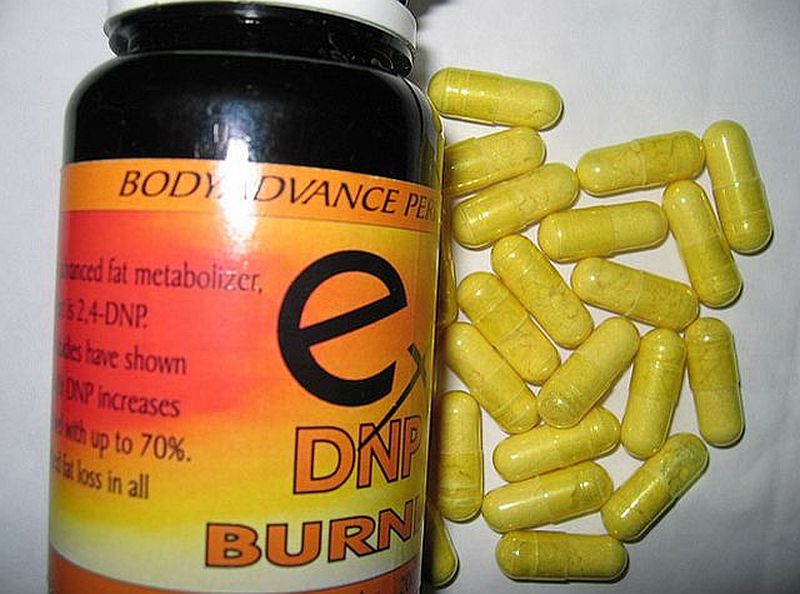
DNP (dinitrophenol) is a synthetic chemical product which can induce very rapid fat loss when taken orally. It accomplishes this by strongly or even dangerously increasing body temperature and metabolic rate. I have to rate DNP as the harshest and most dangerous drug used in bodybuilding.
Although one might think such a drug would be used principally by the highly advanced and elite, this has not been my experience. Generally, these bodybuilders achieve their condition without DNP; the product instead tends to be a crutch for those needing a crutch.
In no case do I think better condition is achieved with DNP than are obtainable without it but with proper planning and execution of diet, training, and use of other drugs if any. That said, DNP is a compound that nonetheless sees considerable use and if nothing else, is a product which is remarkable for its fast fat-loss results.
History of DNP use for fat loss
DNP was first used for fat loss in the 1930s, with the most prominent DNP doctor of the day administering 350 mg/day, and commercial products typically providing 100 mg per capsule. An estimated 100,000 people used DNP during this period; some unknown but substantial number of deaths occurred, and about 2.5% of users developed cataracts. The FDA soon pulled DNP from the American market, thus ending its first period of use.
The Soviet Union, however, recognized a quite valuable use for DNP. For soldiers under conditions of extreme cold, DNP administration could increase their body heat production. I don’t know the extent of their use of DNP for this purpose, but for example DNP capsules could make a potentially life-saving addition to a cold-weather survival kit. (I would do this myself in such a situation, though personally in no other case would I use DNP.)
A Russian-born American doctor was aware of this, and in the 1980s decided to profit from the knowledge. He treated about 14,000 patients with DNP before being sent to prison for unrelated reasons.
This brings us to the current era of DNP use. Dan Duchaine learned of this doctor’s work, and introduced the modern use in bodybuilding.
Mechanism of action of DNP
For those familiar with cars or trucks with manual transmissions, or with motorcycles, DNP essentially works like keeping the clutch slipping all the time. The engine (the mitochondria) may be putting out a lot of power, burning gas rapidly, and generating a lot of heat, but much of the power is not getting to the wheels. Instead, it’s going into heating the clutch. Obviously, one ordinarily slips the clutch for only short period of time. But with DNP, the “clutch” (proton gradient) of the cellular machinery is made to slip all the time. The result? A lot of heat production, and a lot of fuel burned. And not that much energy actually making it to productive use.
More specifically speaking, DNP induces proton leakage from the mitochondria, causing them to have to burn more fuel to yield the same amount of ATP in the cell, or even perhaps less ATP than normal.
DNP dosing and duration
Those who advocated DNP use commonly consider 200 mg/day to a minimum useful amount, and 400 mg/day to be a reasonably-tolerable maximum. Some, however, use 600 mg/day.
A very substantial percentage of individuals, perhaps as much as 10%, are allergic to DNP. A first-time user therefore should use no more than 200 mg/day for the first two days, to assess tolerance.
Duration of use is often only about 2 weeks.
Diet and DNP
DNP use requires at least normal carbohydrate consumption to avoid “crashing” entirely. By no means should a ketogenic diet be followed.
Daily calories are ordinarily no less than maintenance, and are often much more, due to overwhelming desire to eat.
Training and DNP
Intensive training is not possible while using DNP. Work done is usually with light weight.
Side effects of DNP
Large or even dangerous increase of body temperature, intense sweating, yellow bodily fluids, lethargy, water retention, insomnia, hunger, nausea, dehydration, electrolyte depletion, shortness of breath, reduction of insulin production, and reduction of T3. Frequency of these side effects is about 100% except, for example, frequency of nausea might be only about 25%, and dehydration and electrolyte depletion are avoidable.
Conclusion
With proper planning and execution, there’s always a better way than using DNP for fat loss, but where these have failed or are not bothered with, DNP can be effective, but it is a harsh product.
About the author
Bill Roberts is an internationally-recognized expert on anabolic steroids and performance-enhancing drugs (PEDs). He received a bachelor degree in Microbiology and Cell Science and completed the educational and research requirements for a PhD in Medicinal Chemistry at a major American university.
Bill entered the nutritional supplement industry prior to completing his doctoral thesis but his education was invaluable so far as being able to design/improve nutritional supplement compounds, since it was in the field of designing drug molecules and secondarily some work in transdermal delivery.
His education was not specifically "geared" toward anabolic steroids other than expertise with pharmacological principles having broad applications. This has allowed Bill to provide unique insight into the field of anabolic pharmacology with knowledge of points which he would not have known otherwise.